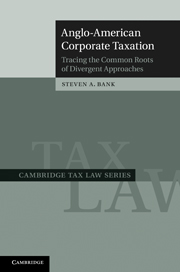3 - The United States
from Part I - Twentieth century and the divergence in systems
Published online by Cambridge University Press: 07 October 2011
Summary
While the United Kingdom maintained its integrated approach through most of the pre-World War II period, the United States soon diverged from this path. As it turned out, the Pollock case discussed in Chapter 1 was only a temporary bump in the road to a corporate income tax in the United States. In 1909, soon after it sent the Sixteenth Amendment to the states for ratification, Congress passed a corporate excise tax as part of the Payne–Aldrich Tariff Act. Although styled an “excise tax,” it was effectively an income tax because the excise was measured by a corporation’s net income. Since it was not accompanied by an individual income tax, however, the risk of double taxation was minimized. Upon ratification of the Sixteenth Amendment, a corporate income tax was once again adopted as part of the individual income tax imposed under the Revenue Act of 1913. Just as in the 1894 Act, double taxation was avoided by excluding dividends from the individual income tax base. This method of integrating the corporate and individual income taxes served as a model until the dividend exclusion was removed in 1936. Since that time, Congress has employed a variety of different methods to partially alleviate the burden of double taxation, but it has never seriously considered eliminating the corporate income tax altogether.
Revenue Act of 1913
Upon ratification of the Sixteenth Amendment, Congress adopted a corporate income tax in conjunction with the individual income tax imposed under the Revenue Act of 1913. As mentioned above, Congress minimized the risk of double taxation by excluding dividends from what was called the “normal” tax on individual income. Under the 1913 Act, all individual income was subject to a “normal”, or base, tax levied at a flat rate of 1 percent. When income reached a certain level, a surtax was applied at progressive rates reaching as high as 6 percent. The corporate income tax rate was explicitly tied to the (individual) normal tax so that a rise in the normal tax rate would be matched by an identical rise in the corporate tax rate. By exempting dividends from the normal tax, Congress ensured that corporate and non-corporate income was treated similarly. Corporate income distributed as a dividend was subject to both the 1 percent corporate income tax and the individual surtax, if applicable, but not to the normal tax, while non-corporate business income was subject to both the 1 percent normal tax and the surtax, if applicable, but not to the corporate income tax. As a result, the 1913 corporate income tax, like its predecessor under the 1894 Act, was a quasi-withholding provision for the individual income tax.
- Type
- Chapter
- Information
- Anglo-American Corporate TaxationTracing the Common Roots of Divergent Approaches, pp. 70 - 104Publisher: Cambridge University PressPrint publication year: 2011
References
- 21
- Cited by



